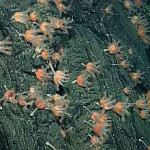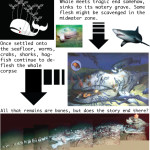Lots of cool stuff from New Scientist in the last week! Don’t have much time to offer an analysis of them as I am down in North Carolina house-hunting. But I encourage you to “tawk amongst ya selves”. Here are some wet offerings:
Giant Vacuum Cleaner Leaves Reefs Thriving
“To create the Super Sucker, biologists modified a system designed for gold dredging. Seaweed from reefs is sucked up and dumped onto mesh sorting tables on a barge. Native organisms inadvertently vacuumed are removed and returned to the reef and the seaweed is eventually used by farmers as fertiliser.
(snip)
The researchers could only remove about 90% of the seaweed, so they expected that the algae would grow back, necessitating periodic cleaning. Instead, within weeks, the remaining seaweed was gone and two years later it has still not returned.”
Colliding Continents Create Havens for Life
“”Temperature is certainly facilitating diversity, but if it was only temperature in the Eocene, you would have really high diversity in modern Africa,” says lead author Willem Renema of the Natural History Museum in Leiden, the Netherlands.
“We realised these are distinct locations where you have major complex collisions between continents.”
At the early phase of collision, Renema says, a lot of new and different habitats are created, such as rocky and sandy shores, and deep and shallow basins, all of which can accommodate a lot of different species.
The current IAA hotspot lies in the region of convergence between the Eurasia, Australia and the Pacific/Philippine Sea plates.”
“Christian Haas of the Alfred Wegener Institute for Polar and Marine Research in Bremerhaven, Germany, and his team estimated the thickness of late summer ice at the North Pole in 2001, 2004 and 2007. They found that the ice was on average 1.3 metres thick at the end of the summer in 2007. By contrast, its depth was 2.3 metres in 2001 and 2.6 metres in 2004.
(snip)
Previously, glaciologists had measured ice thickness in spots by placing instruments directly on the ice. Records from 1991 show that the summer ice that year was 3.1 metres thick.”
Hmm… I think I see a trend there!






Well, I guess if the extent of the arctic ice isn’t being reduced as forecast there’s always the shift to thickness to point at. Very resourceful, these grant driven enterprises.
The NS is so good that you summarized it, and then I poached off your summary.
That’s a lot of imitation as flattery.
thanks…
thanks…
thanks…